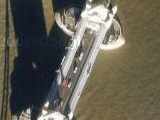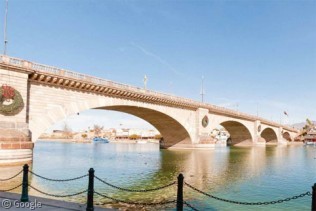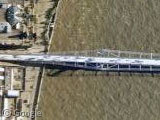The True Story of London Bridge
Wednesday, 15th July 2009 by Alex Turnbull
This rather innocuous-looking bridge over the River Thames is the latest in a long line of bridges to stand on this spot and lay claim to the name London Bridge.
This current bridge opened in 1973, but a bridge has existed at or near this very spot since the Roman occupation of the area, around 2,000 years ago. There were a number of bridges during this time, but it wasn't until 1209 that a truly great bridge was erected.
The Medieval London Bridge took a seriously lengthy 33 years to build, but it would have been pretty impressive in its day, as it was completely covered in shops set in the base of buildings seven stories tall!
For 600 years the Medieval bridge was a bustling and relatively safe haven in the centre of London, but eventually it was decided that it was too old, narrow and decrepit1 to serve Londoners any longer, and that it should be replaced.
In 1799 Thomas Telford proposed a bridge with a single iron arch that would span the entire river, but it was rejected due to worries about feasibility. The bridge that was finally completed in 1831 was built 30 m west of the Medieval one, and was designed by Scots civil engineer John Rennie.
By 1896 the "New" London bridge had become the busiest point in London (with around 9,000 people crossing every hour), so it was widened by 4 metres to combat the acute congestion. On the disused railway track at the old Swelltor Quarry on Dartmoor, you can still see left over granite pillars that were quarried as part of this process, but never used.
Unfortunately the bridge couldn't cope with the extra weight – after widening, it began to sink by about 3 cm every 8 years, meaning that yet another new bridge would be required.
However, instead of knocking the bridge down, in 1967 the City of London council hit upon the brilliant idea of putting the bridge up for sale; and on 18 April 1968, Rennie's bridge was sold to the American entrepreneur Robert P. McCulloch of McCulloch Oil for $2.4m dollars, and subsequently moved, brick-by-brick to Lake Havasu City, Arizona.
The story goes that McCulloch mistakenly believed he was buying (the frankly much more desirable) Tower Bridge, but of course this has been vehemently denied. Regardless, the reconstructed London Bridge forms the centrepiece of a English-style theme park that has since become Arizona's second most popular tourist attraction, being only less-visited than the Grand Canyon.
(London Bridge was previously featured back in 2006 before the advent of Street View).
-
Which would explain the origins of the associated nursery rhyme very neatly. ↩︎










Isnt the whole ‘Thought he was buying Tower Bridge’ thing a bit of a whopper? I think there is even footage McCulloch visiting the bridge during its ‘demolition’ to over see things – he knew exactly what he was buying. Also, Tower Bridge is all fancy and that but London Bridge was, by any standards, a very elegant bridge.
The whole Dartmoor quarry thing is fascinating aswell – i did not know that. Once again GSS fills my already over flowing brain with useless but slightly interesting knowledge (like it needed anymore!)
is it only me, or is there a large sitting sheep drawn few hundred meters SE of Dartmoor quarry?
I see no sheep! Can you provide a link?
https://www.googlesightseeing.com/maps?p=&c=&t=h&hl=en&ll=50.538109,-4.022777&z=18
That’ll be the fella then?
Hmmm, old village/livestock enclosures perhaps?
The arch under the tower of the Church of St Magnus the Martyr (the founder of my family, in passing) marks the roadway of the famous covered London Bridge of the middle ages.